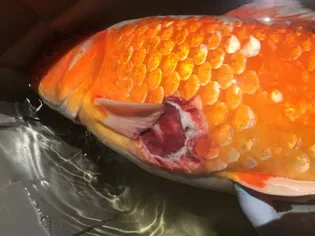Pseudomoniasis in Fish
Updated on 04/26/24

Pseudomoniasis in Fish: A Comprehensive Guide to Understanding and Combating a Devastating Bacterial Disease
Pseudomoniasis is a ubiquitous fish disease that can wreak havoc on both freshwater and marine species. Caused by the bacterium Pseudomonas, this infection manifests in a variety of clinical signs, ranging from subtle to severe, making it a formidable challenge for aquatic veterinarians and fishkeepers alike.
Etiology and Transmission
Pseudomonas bacteria are opportunistic pathogens, meaning they typically exploit existing wounds or stressors. Transmission occurs through direct contact with infected fish, contaminated water, or fomites. Stress factors, such as overcrowding, poor water quality, and inadequate nutrition, can predispose fish to infection.
Clinical Signs
Pseudomoniasis presents with a diverse array of clinical signs, depending on the site and severity of the infection. Common manifestations include:
* Skin and Fin Infections: Reddening, swelling, erosion, and ulceration
* Eye Infections: Cloudiness, exophthalmos (bulging eyes), and corneal ulcers
* Systemic Infections: Lethargy, anorexia, weight loss, and hemorrhages
* Tail and Fin Rot: Progressive decay of caudal fin and other fins
* Septicemia: Invasion of the bloodstream, leading to organ failure and death
Diagnosis
Confirming pseudomoniasis requires a combination of clinical examination and laboratory testing. Bacterial culture and sensitivity testing can identify the presence of Pseudomonas and determine its susceptibility to antibiotics. Histopathology, which involves microscopic examination of tissue samples, can also reveal characteristic lesions.
Treatment
The treatment of pseudomoniasis involves a multi-pronged approach, considering the specific manifestation and severity of the infection. Options include:
* Antibiotics: Systemic or topical antibiotics, such as fluoroquinolones and aminoglycosides, can target the bacterial pathogen.
* Antimicrobials: Other antimicrobial agents, such as methylene blue and hydrogen peroxide, may be used topically to treat external infections.
* Immunostimulants: Supplements that enhance the fish's immune response can support its ability to fight the infection.
* Surgery: In severe cases, surgical removal of infected tissue may be necessary to control the spread of the disease.
Prevention and Control
Preventing pseudomoniasis is crucial for maintaining healthy fish populations. Key strategies include:
* Quarantine: Isolate new fish for observation before introducing them to existing populations.
* Water Quality Management: Maintain clean and well-oxygenated water to minimize stress and reduce the risk of bacterial growth.
* Stress Reduction: Avoid overcrowding, provide adequate shelter, and ensure proper nutrition to keep fish healthy and resilient.
* Vaccination: Vaccines are available for certain Pseudomonas strains, offering protection against specific serotypes.
Examples in Subtopics
Case Study 1: Skin and Fin Infection
A freshwater angelfish presented with red and swollen skin lesions on its body and fins. Bacterial culture confirmed Pseudomonas aeruginosa infection, and the fish was successfully treated with topical and systemic antibiotics, along with immune support supplements.
Case Study 2: Tail and Fin Rot
A saltwater damselfish exhibited progressive decay of its caudal fin, accompanied by lethargy and anorexia. Histopathology revealed severe pseudomoniasis, requiring surgical removal of infected fin tissue and a prolonged course of antibiotics.
Case Study 3: Systemic Infection
A group of juvenile goldfish experienced mass mortality, with signs of hemorrhages and organ failure. Bacterial culture identified Pseudomonas fluorescens as the culprit, suggesting a systemic infection. Broad-spectrum antibiotics administered through medicated feed effectively controlled the outbreak.
Conclusion
Pseudomoniasis is a significant threat to fish health worldwide, demanding prompt diagnosis and effective treatment. By understanding the etiology, clinical signs, and prevention strategies associated with this bacterial infection, fishkeepers and veterinarians can safeguard their aquatic populations and ensure their well-being. Remember, early intervention and a comprehensive approach are essential for successful outcomes in combating pseudomoniasis.
Explore More Pets

Freshwater Aquarium Filters
How to Deal With Cloudy Aquarium Water

Saltwater Aquarium Filters
How Do You Remove Chloramines From Tap Water?

Freshwater Aquariums & Habitat
Can I Keep My Koi Fish Inside?

Saltwater Aquariums & Habitat
14 Best Floating Plants for Your Aquarium

Freshwater Fish Health
How to Treat Ich on Freshwater Fish

Saltwater Fish Health
Fin Rot in Aquarium Fish

Freshwater Aquarium Filters
How to Do Aquarium Water Changes

Saltwater Fish Health
How Do Fish Get Parasites?